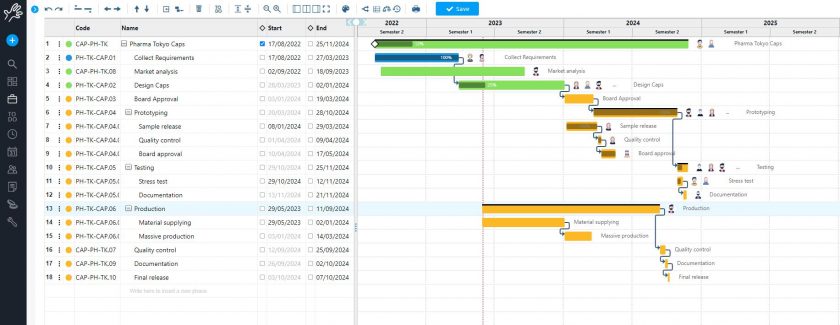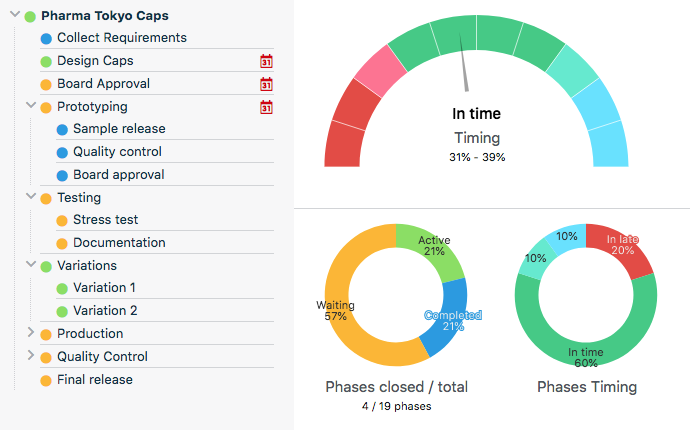Starting a project correctly is the first step to ensuring its success. We often underestimate how important the early stages are for getting things done on time and within budget.
In this article, you’ll find a hands-on checklist to ensure every project gets off to a good start and avoids common mistakes or oversights that can mess up the final result.
CONTENT
- The 10 essential steps for successfully starting a project
- 1. Clear goal setting
- 2. Identifying stakeholders
- 3. Team composition and responsibilities
- 4. Initial planning
- 5. Scope definition
- How to define the scope effectively
- How Twproject helps you define and control your scope
- 6. Risk assessment
- 7. Initial document preparation
- 8. Communication and alignment
- 9. Working tool setup
- 10. Validation and final approval
The 10 essential steps for successfully starting a project
Every early stage, from goal setting to team composition, from planning to communication, plays a key role in ensuring that the project runs smoothly, in a controlled and effective manner.
In this section, we will walk you through the 10 key steps every project manager should follow to start a project in a structured and results-oriented fashion.
1. Clear goal setting
The first question we must ask is: what do we want to achieve? Goals are the power behind every effort. Vague goals could be the first obstacle on the road to success.
An effective goal must be S.M.A.R.T.:
- Specific: What exactly do we want to achieve?
- Measurable: How do we measure success?
- Achievable: Do we have the resources to achieve this?
- Relevant: Is it consistent with our company strategy?
- Time-bound: Within what time frame?
Only in this way will it be possible to complete the project according to expectations..
2. Identifying stakeholders
It is critical to know who is involved in every project: clients, customers, end users, sponsors, and teams.
Stakeholders must be given a voice from the very beginning to understand their needs, expectations, and potential concerns. Their influence can be decisive in project management, especially regarding decision-making.
3. Team composition and responsibilities
Another key step is selecting the members of the project team. Each individual must have clearly defined roles and responsibilities. This improves efficiency and reduces the risk of overlap or operational gaps.
Creating an organizational chart to provide a clear overview of the entire work group is also worthwhile.
The project manager plays a central role here: they must coordinate their team, motivate them, monitor progress, and ease internal communication.
No project can be successful without a well-built team. Selecting the right project team members means choosing competent, motivated people who complement each other. Yet it’s not enough to choose people: you must define roles and responsibilities accurately.
Each team member must be informed about:
- Their operational role
- Delivery schedules
- Project expectations
- Communication procedures
A seasoned project manager promotes collaboration, monitors progress, and prevents internal conflicts, ensuring the team operates smoothly.
4. Initial planning
The planning phase is one of the most delicate moments in project management. Budget estimates are made in this phase, schedules are established, key milestones are defined, and potential risks are anticipated. This is not just a theoretical exercise: robust planning allows you to address critical issues proactively.
Each task included in the plan must be associated with resources, timelines, and responsibilities.
Good planning includes:
- Work breakdown structure
- Schedule estimate (Gantt or roadmap)
- Budget setting
- Resource allocation
- Constraints identification
Strategically planning a project can make the difference between success and failure.

5. Scope definition
One of the most common mistakes in project management is starting without a clear definition of the scope. Frequently, there is a bias toward “doing everything,” but every project has its own specific limitations regarding objectives and resources. An ambiguous definition could lead to confusion, delays, and unexpected budget spikes.
Therefore, the planning phase must include a clear definition of the project‘s scope, stating precisely what is included and excluded from the work to be done.
What does the project scope include?
The project scope can be intended as the set of:
- Concrete objectives to be achieved
- Expected results (deliverables)
- Functionalities or services to be provided
- Technical or time constraints and limitations
- Efforts necessary to complete the project
This definition serves to complete the project in line with expectations, without unauthorized deviations or distractions.
Risks associated with scope creep
When the scope is not clearly defined or documented, there is a risk of “scope creep,” which is the uncontrolled increase in activities and stakeholder requests during the project lifecycle.
Examples of scope creep:
- Extra features requested “on the fly”
- Unplanned activities that keep getting “piled on”
- Changes that are not formally tracked
This can pose a huge hindrance to delivering the final result on schedule and within budget.
How to define the scope effectively
- Involve stakeholders from the get-go
Talk to customers, sponsors, and end users to understand their real needs.
- Use requirements collection techniques
Interviews, workshops, brainstorming sessions, surveys: every project must be based on concrete input.
- Prepare your scope document
Write an official document that describes in detail:
- Goals
- Boundaries (what is included/excluded)
- Deliverables
- Major milestones
- Create a WBS (Work Breakdown Structure): Break down your project into smaller hierarchical components. This helps visualize the whole effort and makes planning easier.

- Get formal approval: Sponsors and stakeholders must approve the scope document before launch.
How Twproject helps you define and control your scope
Twproject is a project management software designed to support every project phase, including the critical task of defining and controlling its scope.
Here’s how it can help you:
Clear communication with your team: project team members can clearly see what is (and is not) part of their work, reducing ambiguity and unauthorized extra activities.
Visual project design: With Twproject, you can build your WBS directly on the platform, displaying each sub-activity in a clear and intuitive tree structure.
Deliverable and milestone definition: associate expected results, deadlines, and responsibilities with each task. This gives the project manager constant control over the work required to complete their project.
Scope change management: Every change to the scope must be tracked. Twproject logs changes, keeps historical versions, and notifies stakeholders of changes, reducing the risk of scope creep.
Link between scope, budget, and resources: the efforts defined in the scope are connected to costs and assigned resources. This means that every extension of the scope has a measurable impact, promoting informed decisions.
6. Risk assessment
Every project could be vulnerable to risks: unexpected technical issues, delays, lack of resources, problems with suppliers. Anticipating these risks at the initial stage can be crucial in ensuring you are not caught unprepared.
The risk checklist should include:
- Internal and external risks
- Likelihood of occurrence
- Potential impact
- Prevention or response strategies
Good risk management is one of the key skills of any project manager.
7. Initial document preparation
Documenting means clarity and traceability. Every project must be supported by a number of key documents, including:
- Project charter: The official launch document
- Business case: Financial feasibility analysis
- Project plan: Outlines activities, timelines, resources, and budget
- Risk register: Includes all potential issues mapped out.
- Stakeholder register: Lists the parties involved
This documentation helps keep track of decisions and project developments over time.
8. Communication and alignment
One of the most overlooked yet critical elements is internal communication. Often, project problems arise not from technical errors but from a lack of team alignment.
It is crucial to define:
- A communication plan (who communicates what, when, and how)
- A reporting and update system
- Collaboration tools accessible to everyone
An informed team can be responsive, motivated, and accountable. The kickoff meeting is the perfect moment to officially launch the project and share objectives, strategies, and tools.
9. Working tool setup
To start a project in a structured way, it is important to have adequate digital tools. Project management software such as Twproject helps you to:
- Organize activities
- Allocate resources
- View the project life cycle
- Monitor the final result
- Keep track of progress
Twproject offers a full-featured environment for project management, integrating planning, communication, time tracking and document management capabilities into a single platform.
10. Validation and final approval
The final step on this checklist is to get official approval from stakeholders. This means that the plan, budget, and resources have been validated, and the project can begin.
The validation:
- Certifies feasibility
- Confirms alignment between parties
- Formalizes organizational commitment
- Authorizes activity execution
Without this step, virtually any project could be at risk of ambiguity and delays. The final green light signals that everything is ready to proceed confidently.
Every project starts with great ambitions, but only those that are well thought out actually achieve their final outcome. Following a project launch checklist ensures that no critical aspects are overlooked, that the team is involved, and that work is carried out in a structured and efficient manner.
Project management is not just a technical matter, but also involves methodology, communication, and strategy. A good start could be the key to completing even the most complex projects.
Remember: a successful start must be backed up by the right tools, strong leadership, and a shared vision. That’s why equipping yourself with project management software such as Twproject can make a difference at all project stages.




